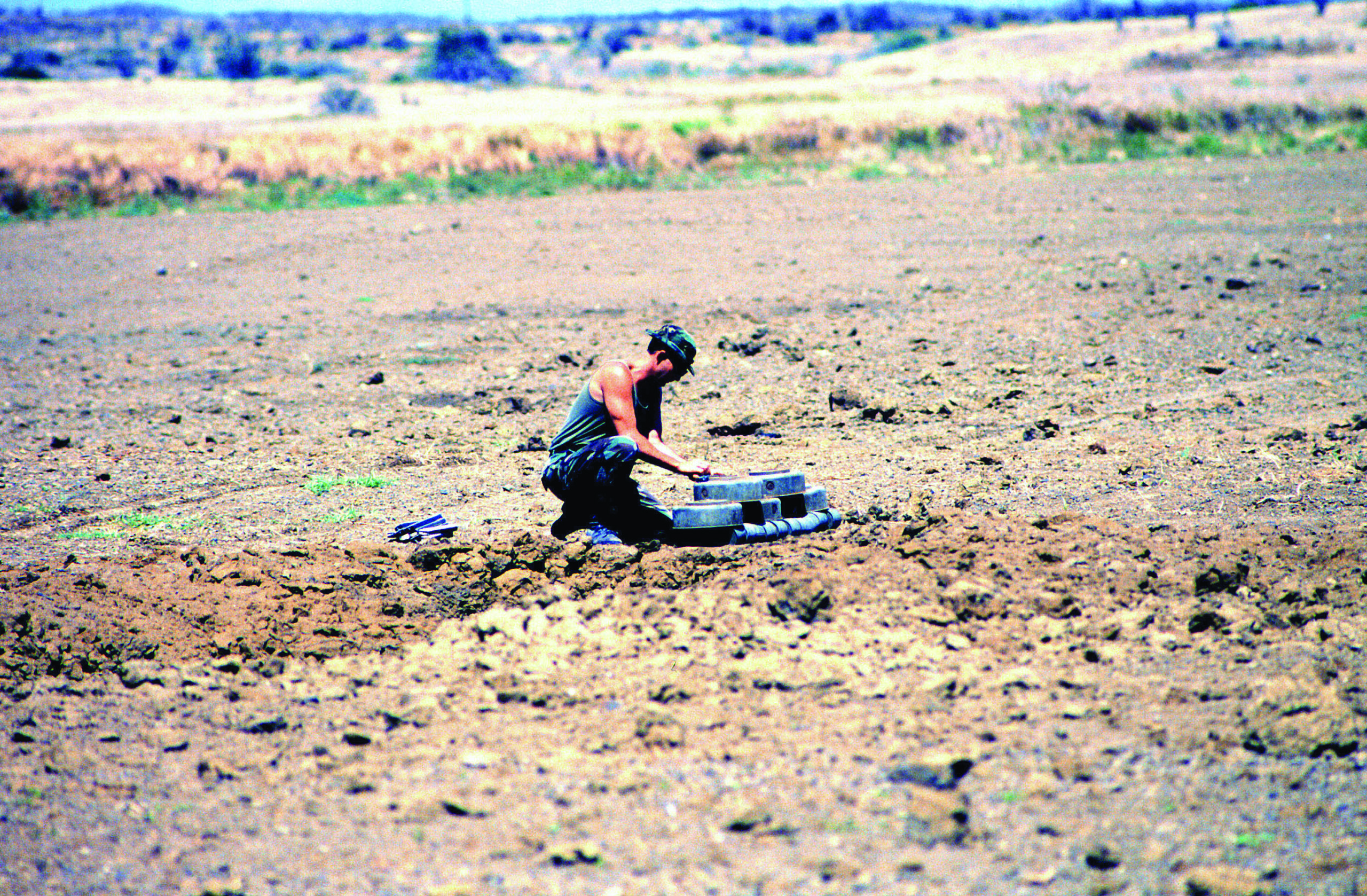
The Ear and the Finger: Minefield Maintenance at Guantanamo Bay
By: Kyle WattsPosted on September 15, 2024
For nearly 40 years, a small group of Marine Combat Engineers performed a special duty at Naval Station Guantanamo Bay, Cuba. On a daily basis, Marines from the Minefield Maintenance (MFM) section entered the minefields surrounding the base to locate, dig up, and replace the live explosives. Their uniquely hazardous job offered the only place a Marine could obtain a combat fitness report for some of the time the unit existed. Now, more than 20 years after their final deactivation, veterans who worked the fields remember their time at “Gitmo” as the highlight of their career.
The United States established its presence at Guantanamo Bay in 1903. Engineers began laying mines in 1961 and completed the fields the following year in the wake of the Cuban Missile Crisis. The Marine barracks at Gitmo established MFM concurrently with the defensive barrier’s creation. Twenty-one different minefields surrounded the 17-mile perimeter of the base, packed with 55,000 mines. Detailed maps identified the exact location of every mine and “strip line” crossing the fields, the designated paths along which the Marines could advance in relative safety.
Before Marines joined MFM, they underwent a month of training and evaluation at Courthouse Bay, N.C., at the Corps’ basic combat engineer school. Those who passed advanced on to Cuba, where MFM Marines put them through two more weeks of rigorous testing in a practice field. In one exam, students were required to use their mine detector to locate the head of a nail with accuracy and consistency. Engineers who could not make the cut received assignments to other duties or returned to the States. Evaluation continued throughout their tour. Officers and Navy corpsmen analyzed the Marines every morning at breakfast to gauge their mental state and fitness for duty. Marines who exhibited traits such as overconfidence or reckless actions could be permanently pulled from the fields.
In order to enter the minefields, an orchestrated series of puzzle pieces must fit together perfectly. Depending on the size of the field being worked, one or more two-man teams prepared to cross the wire for the day. Back up teams geared up as well, in the event that anything went wrong with the primary teams. The Marines wore Korean War-era sateen uniforms, protected by nothing but a flak jacket and “diaper,” ballistic lower torso armor also left over from Korea. Prior to beginning work on a new field, the engineers burned off the vegetation. They circled the perimeter standing on top of a tanker truck, armed with a fire hose, dousing the earth with aviation fuel. The ensuing conflagration destroyed everything in its path, leaving a barren landscape on which to work.
A duty engineer oversaw the operation, with someone to work the radio, a corpsman, and additional personnel to drive the vehicles and hump old mines away from the wire, or new mines in. For a section limited to only 20 to 25 Marines at a time, daily operations involved nearly every Marine present. A helicopter remained on call to promptly evacuate any casualties. If at any time the chopper was unable to arrive within 20 minutes, operations halted until the helicopter again became available.
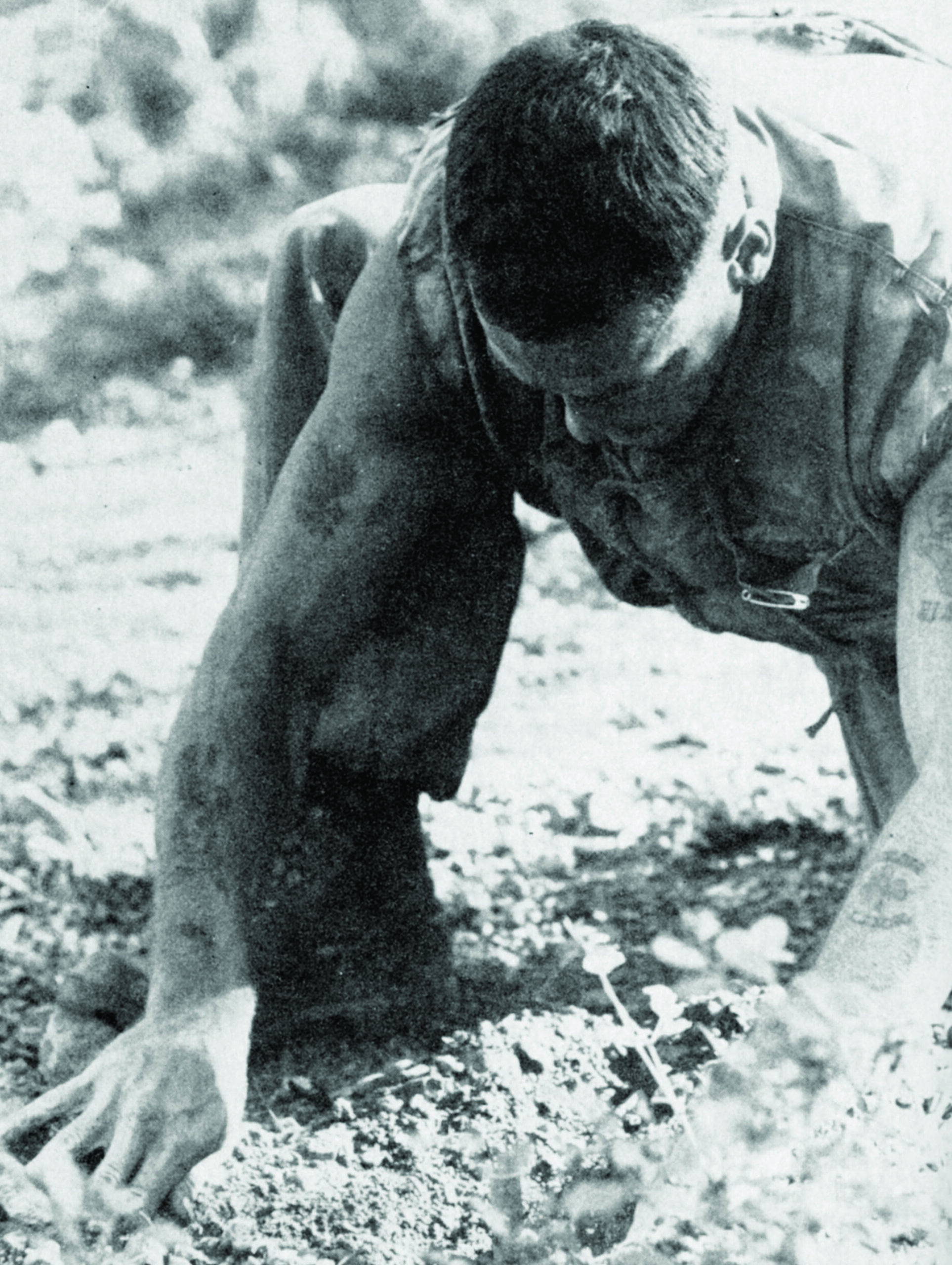
Everything done was to provide the safest environment possible for the two-person team, which was composed of the “ear” and the “finger.” Every Marine in the section was certified and pulled their weight as an ear or finger, including the officers. When the Marines crossed the wire, rank ceased to exist.
The ear advanced first with a metal detector. He walked the strip line until he arrived where a mine cluster should be located. Each cluster consisted of five mines; one large antitank mine surrounded by four smaller anti-personnel mines. Sweeping back and forth, the ear moved off the strip in search of the antitank mine. Once located, he called up the finger and identified the location.
The finger dug out and removed the mine to the strip line. Next, the ear returned to locate the antipersonnel mines. Standing in the hole left by the antitank mine, the ear swept slowly around in a circle. Each smaller mine should have been buried within two paces. Once identified, the ear placed a wooden dowel on the ground pointing to the three-pronged fuse. The finger then returned to disarm and dig up the four remaining explosives. A typical day began well before dawn, placing teams in the fields at first light. Their goal each day was to complete 10 mine clusters, whether removing or replacing. Some went quickly and easily. Others proved more difficult.
“That dowel rod pointed right at the fuse, but if you couldn’t see it you had to probe around for it. That was the most disturbing thing you had to do,” remembered George Van Orden, a MFM veteran from 1991 to 1992. “Depending on the angle you hit it, you can set a mine off with fingernail pressure. Uncovering that antipersonnel mine was the most dangerous part.”
Bob Fitta arrived at Gitmo in 1975. He entered his first live minefield as a finger. He looked on with expected nerves as his ear located the antitank mine on their first cluster of the day. Fitta popped the mine out of the ground effortlessly, feeling his confidence swell; his first live mine in the books. The ear marked the locations of the four antipersonnel mines. Fitta returned and discovered the mines were nowhere in sight. He drew his pocket knife, knelt in the antitank mine hole, and began digging.
“I dug a hole probably 18 inches long, 12 inches wide, and an inch or two deep,” Fitta remembered. “I couldn’t find that damn mine to save my life. I called the ear back up two or three times and he kept saying, ‘yeah it’s right here, it’s right here.’ The last time he came up, he did it again then started slapping the battery pack on his mine detector. Keep in mind, this was my first cluster ever. I’m looking at him and he’s slapping this damn machine and I’m just like ‘what in the hell are you doing?’ He flipped the thing up on his shoulder and looked at me and just said, ‘detector’s broke. I gotta go get another one.’”
The ear returned and repeated the process. He adjusted the markers over to the locations identified by the new detector. Fitta knelt in the hole and scanned the dirt. His adrenaline and anxiety peaked.
“The tip of a prong was sticking out of the dirt less than a quarter inch from my fingerprint where I had been pressing down on the ground digging,” he said. “It took me close to two hours to finish that cluster. I was covered in dirt and sweat and after it was done, I had to go out and take a break.”
Despite the maps, surrounding fences, and signage identifying the hazards, accidents occurred. In 1964, five U.S. Navy Sailors on liberty from their ship wandered into a minefield after dark. On their way to the beach, wearing swimsuits and carrying towels, all five stumbled across a cluster of mines and were killed in the resulting explosions. Several Cuban defectors also lost their lives, either escaping Cuba for sanctuary within the American base, or escaping U.S. confinement and returning to the communist controlled part of the island.
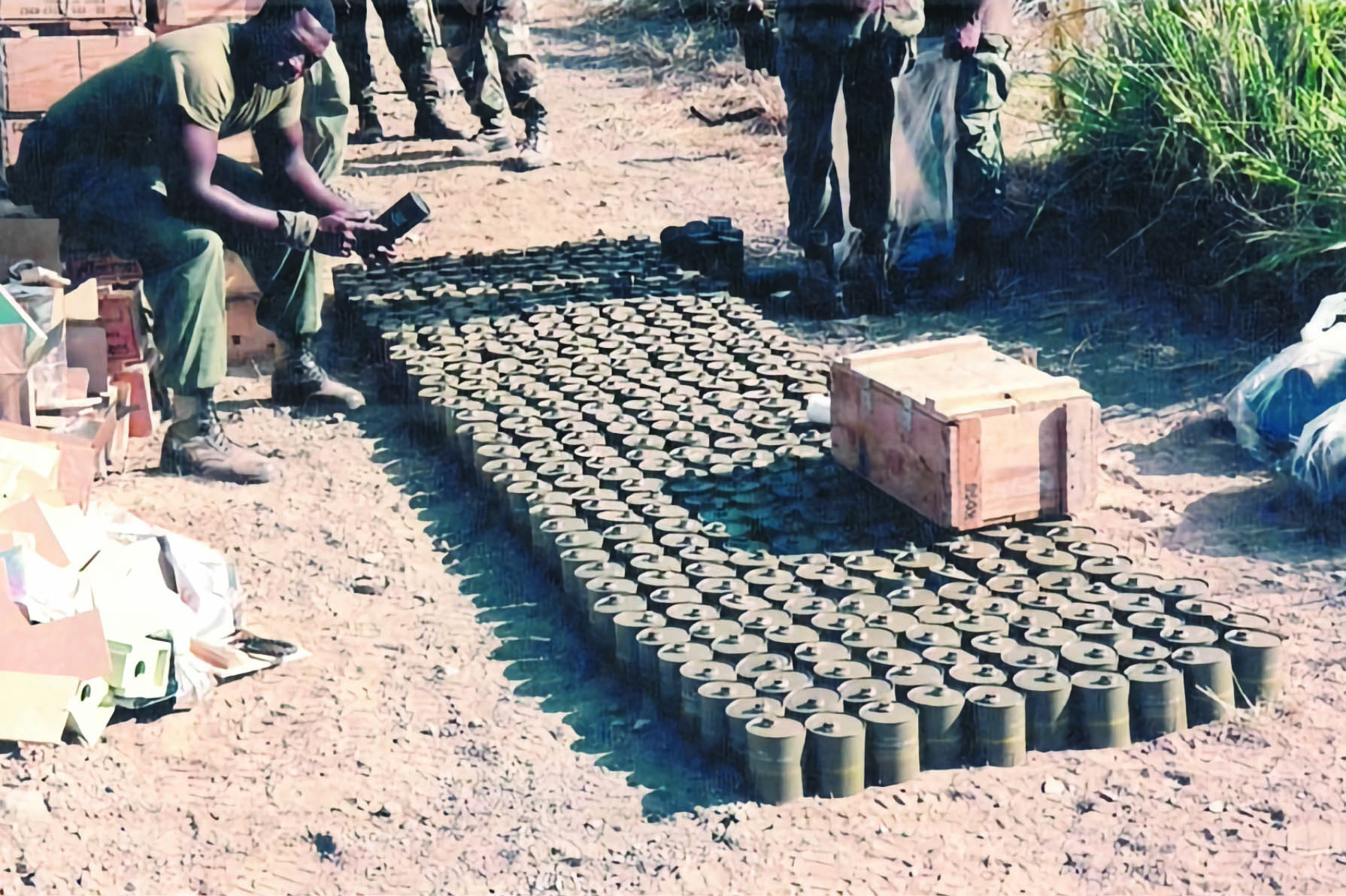
On several occasions, Cubans knowingly entered the minefields in their effort to escape communism. One man lost a foot to an exploding mine but regarded the injury as a small sacrifice to pay to have reached the American base with his life. Another time, Americans found a Cuban wandering through base housing. He explained his crossing of the minefields and turned over a detailed map of the minefield he successfully navigated. How the map came into his possession remained a mystery.
Marines tasked to work the fields suffered casualties as well, particularly through the early years. Two MFM engineers died in the minefields the same year the unit was organized. Three more were killed in 1965. Officers overseeing the program banned junior Marines from the section, hoping a higher level of rank and maturity would decrease the number of accidents and close calls. Two MFM sergeants died in 1966, adding to the section’s lessons learned in blood. In total, 13 engineers died working in the minefields throughout the unit’s history.
Each incident initiated SOP changes for working in a minefield. They served as poignant case studies and reminders for newly arrived Marines on the difficulty they faced and absolute focus required to do the job safely. Each heard the story of one Marine who sat on an antitank mine for a smoke break, believing the explosive to be disarmed. Another story told of an ear who stepped on an antipersonnel mine while sweeping back and forth with a mine detector, searching for the mine where he believed it should be rather than where it actually was. Whenever an accident occurred, the Marines did their best to identify what went wrong and ensure it would not happen again.
“Since everyone was at least 30 meters away, it was nearly impossible to tell exactly what a Marine was doing when the mine went off,” said Van Orden. “The SOPs changed every time someone died to ensure we all did the job in the same order.”
The equipment MFM carried or wore accounted for numerous close calls or even deaths. Early on, the Marines stopped wearing helmets in the fields after several of them fell off and detonated a mine or nearly triggered one. The steel pots offered virtually no protection in the first place, and Marines replaced them with bandanas or boonie covers to combat the heat. In later years, Marines clipped their pocket knives and other gear to their flak jackets, rather than simply placing them in a pocket, after a Marine died when his knife apparently fell from his pocket and detonated a mine when he bent over.
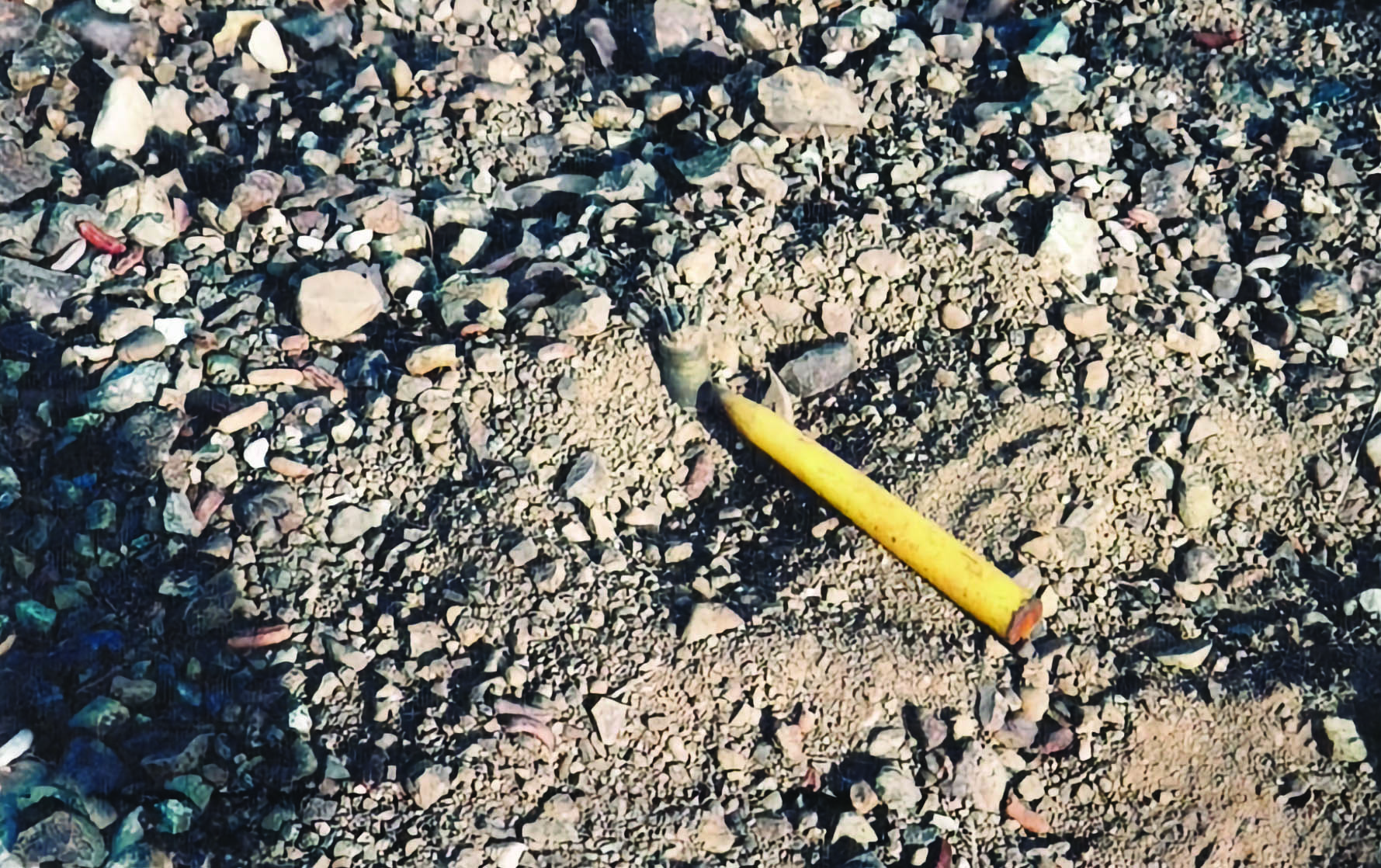
Mines often presented with complications. Extreme weather and growing vegetation moved the dirt and buried mines or submerged them in water. After burning a field, the fuse of some mines would melt, leaving it nearly impossible to disarm. Mine defects sometimes actually spared the lives of Marines rather than putting them at greater risk. The antipersonnel mines consisted of two separate explosive charges; one to shoot the primary charge out of the ground to detonate a few feet off the ground, and the second to provide the killing blow. Many Marines found “out of the can poppers” lying on the ground; mines that fired out of the ground, but failed to explode. Those who experienced them firsthand were left stunned by their brush with death.
In the late 1980s, one Marine finger worked a cluster on the side of a steep hill. He inadvertently dislodged a rock that rolled away down the slope. The rock landed in a cluster at the base of the hill and triggered an antipersonnel mine. The charge exploded from the ground and soared up the hill, landing just feet away from the Marine. The faulty popper mercifully failed to detonate the primary charge. The Marine returned as one of the very few who survived a detonation in a minefield.
If everything worked properly, every procedure perfectly followed, and every mine cooperated as it should, the Marines could still easily die. Unintentional explosions occurred frequently. The vast majority of these resulted from deer moving through the fields. MFM investigated every explosion. Quite often, the Marines found dismembered pieces of deer scattered around the area. Flocks of buzzards, dubbed by Marines “the Cuban air force,” circled and descended daily cleaning up the scraps. No amount of mine explosions or hunting could adequately combat the deer population. Indeed, the abundance of deer at Gitmo created one of the most dangerous conditions for MFM.
“We were the only ones allowed to hunt out there, and there were no natural predators to kill the deer other than the minefields, so they populated like crazy” remembered David Brooks, a MFM officer from 1992 to 1994. “Between the guys that like to fish and the deer, we had some of the best barbecues on the island.”
The Marines adopted standard practices to thwart the deer. Before entering a field each morning, Marines drove a vehicle around the perimeter with a siren blaring, hoping to startle any deer in hiding and oust them from the field. In later years, a Marine carried a shotgun as the designated hunter and would open fire as soon as the deer crossed out of the wire. Despite the counter measures, almost every MFM veteran has a story of a deer encountered in a minefield.
Frank Miller’s deer encounter came in 1990, just a few weeks into his tour. Miller advanced down a strip line into a field as the finger laying new mines in the ground. With four clusters installed behind him and working on his fifth, a horn suddenly blasted from the road behind him.
“That was the signal for a deer in the field,” Miller said. “I got down on the strip line, which was the SOP. They started yelling, ‘Miller, don’t move! There’s a deer coming your way!’ I could hear him running up the hill at me.”
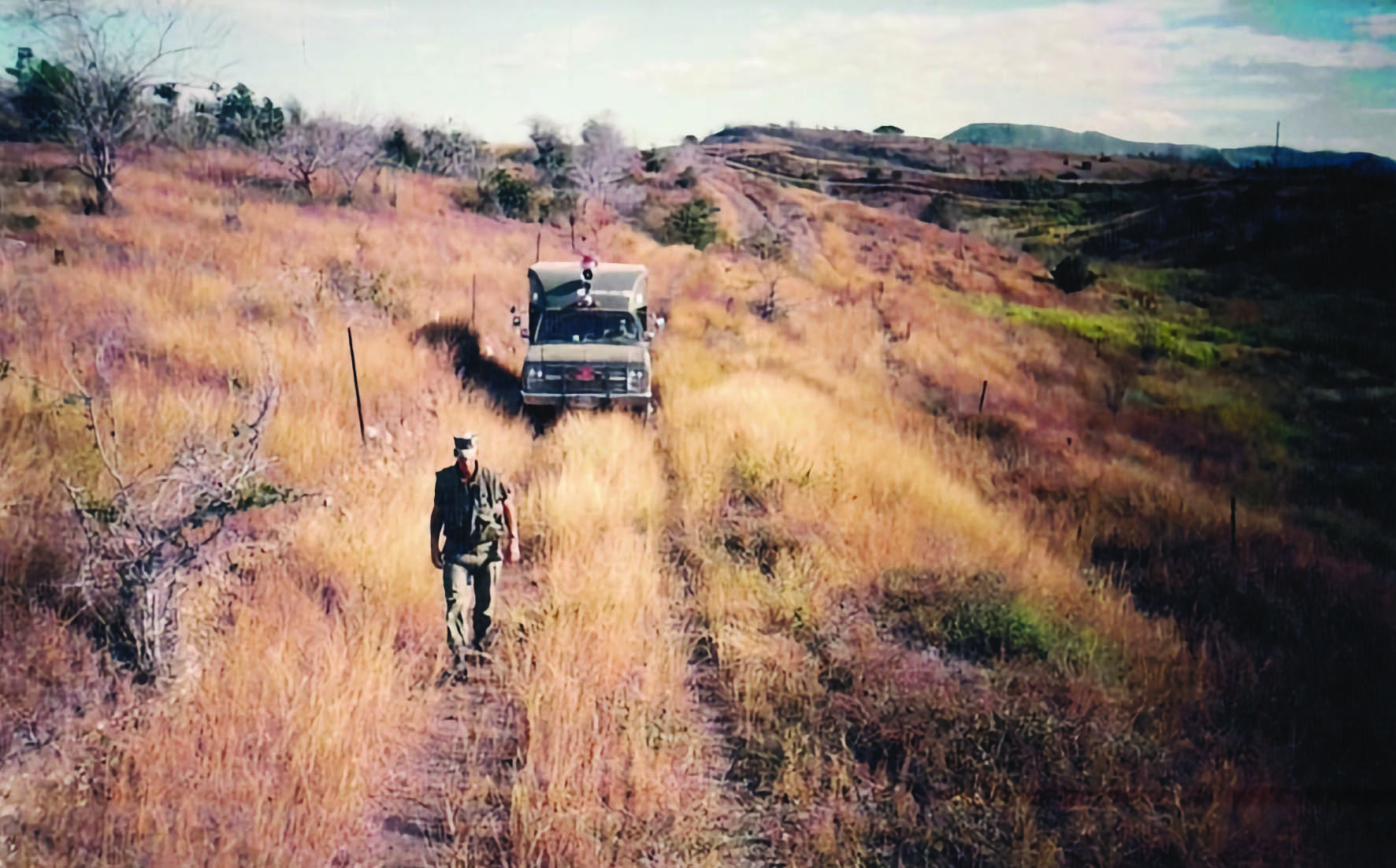
The deer sprinted parallel to the strip line, straight through the four clusters Miller had just put down. Somehow, the deer dodged all 20 mines and veered away out of sight.
“I don’t know exactly how close he got to me,” Miller said. “I can tell you it was close enough that I was trying to dig underneath that cable.”
A special breed of Navy corpsmen joined MFM in the fields. In order to work with the section, corpsmen endured the same minefield training as the Marines. They also received advanced medical training.
“We were essentially put in the role of a pre-hospital paramedic so we had to have all the abilities of that level of care, including artificial airways and advanced trauma life support” said Bryan “Doc” Ritter, who served in Gitmo from 1988 to 1991. “After going through all that, we had to learn how to do the Marines’ job. We had to learn about the ears and the fingers, the mine clusters and the strip lines, everything learned in the practice field before we actually got to go into a live minefield.”
The corpsmen practiced casualty evacuations to elevate their speed and performance in the event an incident occurred. These hyper realistic exercises included evacuating the simulated casualty from a live minefield and loading him onto a helicopter for transport to the hospital. The event ended after the Marine was evaluated by hospital staff and rushed into an operating room. Despite the multitude of close calls over the decades, relatively few incidents occurred requiring medical evacuation.
“Quite frankly, minefield duty for corpsmen was pretty boring,” remembered Ritter. “A lot of people have asked me when we were in the minefields what did we do? I usually tell them about six hours of the day I just sat playing spades with the Marines praying no one would get hurt. It was boring right up until it wasn’t boring.”
Ritter understood this sentiment better than most minefield corpsmen. He served as the senior doc on the team in 1990 when the last Marine to die in the minefields lost his life.
Navy Explosive Ordnance Disposal technicians assisted MFM with getting rid of old mines. Twice a week, Marines drove truckloads to the EOD range where antitank mines were stacked in neat piles with anti-personnel mines lining both sides of the stack.
“They’d place a quarter stick of TNT in each stack and detonate 10 stacks every Tuesday and Thursday,” said Brooks. “Those explosions would send shockwaves throughout the entire base.”
The day Brooks’ wife joined him in Cuba happened to be an EOD “blow day.”
The explosions knocked open the door to his room in the bachelor officer quarters. His wife ran out to the balcony, expecting to see a mushroom cloud billowing in the sky or communist tanks rolling down the street. Another Marine sat on the balcony next door, casually smoking a cigarette.
“What’s going on?” Brooks’ wife shouted. The Marine glanced her way, unaffected by the commotion.
“You don’t know? That’s your husband.”
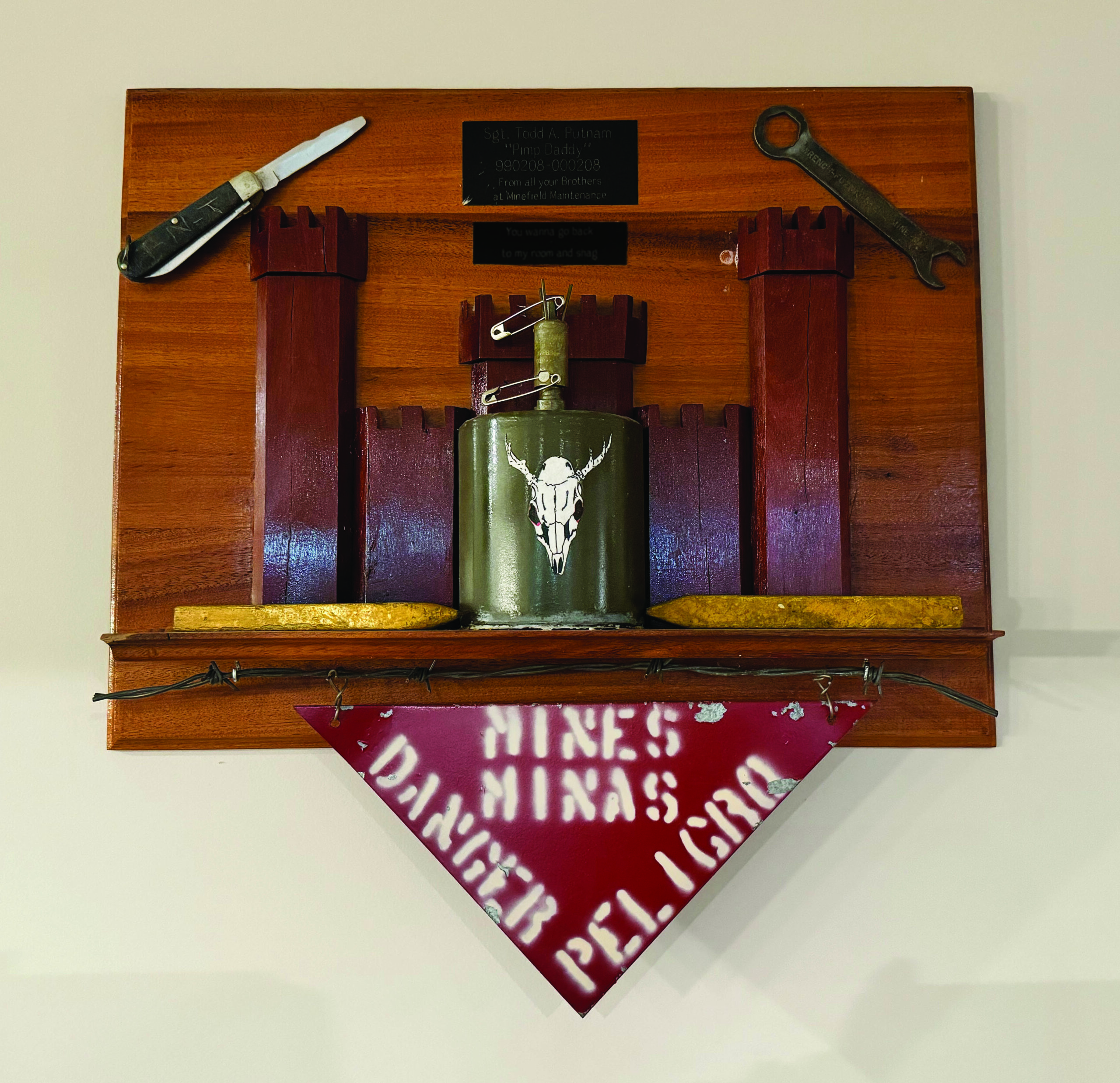
By the mid-1990s, MFM transitioned from placing new mines to only pulling old ones after the Clinton administration ordered the fields removed in favor of other security measures. Marines worked for several years, painstakingly clearing each field one mine at a time. They swept the fields again with detectors once the work was complete. For a final verifiction, explosive-sniffing dogs and ground penetrating radar systems scanned the soil through each minefield. By early 2000, MFM certified the entire base perimeter mine free. The section packed its gear, boxed its records, and shipped its Marines elsewhere. After nearly 40 years of performing their hazardous duty, the section was deactivated.
Whether counting on each other with their lives in the minefields, or roasting a deer together off duty, the minefield Marines of Gitmo shared an entirely unique set of stories that could only have been experienced inside the section. In a world and a Corps that witnessed drastic changes throughout the four decades of MFM’s existence, engineers who arrived in the 1960s or the 1990s performed largely the same job, using mostly the same gear, wearing the same old uniforms.
“Everyone I’ve talked to, when they are asked about Gitmo, they will say it was the highlight of their career,” said Brooks. “The camaraderie you see with these guys is absolutely unbelievable to me. I can’t shake them. It’s been 30 years this year since I left Gitmo, and we are still around catching up and following each other.”
“It was my most rewarding tour,” echoed Fitta.“It was the only place, except for combat, where a Marine engineer actually did his job.”
Today, the gear and records of MFM are housed in storage at the National Museum of the Marine Corps and the USMC History Division. The veterans who served there hope the section will be included in a future display at the museum to recognize their work and sacrifice. In the meantime, MFM lives on through their memories.
Author’s bio: Kyle Watts is the staff writer for Leatherneck. He served on active duty in the Marine Corps as a communications officer from 2009-2013. He is the 2019 winner of the Colonel Robert Debs Heinl Jr. Award for Marine Corps History. He lives in Richmond, Va., with his wife and three children.




